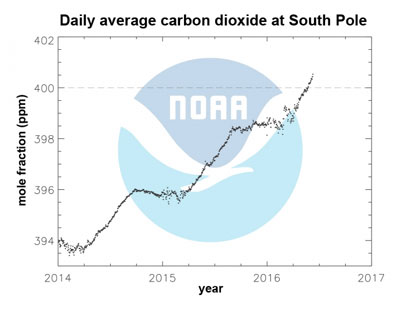For the first time in 4 million years, the entire Earth exceeds 400 ppm of carbon in our atmosphere. On May 23, the most remote place on our planet reached that mark, Antarctica.
Three years ago, the Northern Hemisphere passed 400 parts per million (ppm), where most of the world’s emissions are. It happened for a few days, then months, starting earlier each year. Last year, it spread to the southern hemisphere. Now, the last station on Earth is there … briefly for now.
When the Earth was this warm millions of years ago, global temperatures and sea levels were far higher than today, says Paul Seagrove of British Antarctic Survey, which reported the measurements.
“We know from abundant and solid evidence that the CO2 increase is caused entirely by human activities,” says Pieter Tans, lead scientist at NOAA’s Global Greenhouse Gas Reference Network. “Since emissions from fossil fuel burning have been at a record high during the last several years, the rate of CO2 increase has also been at a record high. And we know some of it will remain in the atmosphere for thousands of years.”
For the past 10,000 years or so, carbon levels have been stable at about 280 ppm, allowing humanity to evolve. Since humans began burning fossil fuels, carbon levels have been growing in lockstep. The more we burn, the faster they grow. With each decade, they have been growing faster and faster. We must stay below 350 ppm to stop Earth’s climate from unraveling. That means the world must warm no more than 1.5°C, which is increasingly unlikely. We’re at 1°C now and and are already experiencing devastating changes.
We must stay below 350 ppm to stop Earth’s climate from unraveling. That means the world must warm no more than 1.5°C, which is increasingly unlikely. We’re at 1°C now and and are already experiencing devastating changes.
Even if all pledges from the Paris Climate Agreement are met, the world will be 3°C (5.4°F) warmer, making parts of the Earth uninhabitable.
Sea levels are a foot higher and Arctic ice coverage is at the lowest levels ever – the ice was gone as of March, months early. Antarctica sheds ice equal to Mount Everest every two years, melting at triple the rate in the last 10 years. We are seeing historic, crippling droughts across the world from California to India, and flooding rains from Texas to France and Germany.
Phoenix, Arizona, for example, could hit 120°F this weekend, and with dry heat comes wildfires, burning right now across the southwest and stoking climate change further by destroying millions of acres of forests. By 2060, this record-breaking heat will be the new normal during the summer, unless emissions are drastically lower.
The oceans are more acidic than in millions of years, cooking coral reefs and depriving marine life of the oxygen it needs to live. Animals and plants around the planet are migrating north.
Even the plants we depend on for food are exposed to so much carbon that nutritional value is declining, and some crops – wheat and corn – are producing toxins as protection from extreme weather. Scientists have “high confidence” that the more the world warms, the lower the nutritional value of agriculturally important crops, says the US Global Change Research Program.
Natural disasters such as floods and heatwaves occur almost daily across the world, double the frequency of 20 years ago, says a United Nations report, Human Cost of Weather Related Disasters. Since 1995, 606,000 people have died and 4.1 billion have been injured, left homeless or in need of aid. The annual bill for cleanup has risen from $14 billion between 1976-1985 to over $140 billion between 2005-2014.
And of course, all this affects economies. There’s an optimal weather band for human societies – around 55°F – where the largest economies right now. As climate change advances, vast migrations of people and animals could end up near Earth’s poles.
What Happens If Emissions Don’t Stop
Even if we stopped all emissions today, we will be living with these changes for at least a century, because carbon takes a long time to dissipate from the atmosphere.
But if we continue business as usual, the situation will get much, much worse. Global temperatures will surely double, say scientists, and could go much higher than that.
In that world, “we have no evidence whatsoever of being capable of supporting the modern world as we know it,” says Johan Rockstrom of Sweden’s Stockholm Resilience Centre. “This gamble risks disaster for humanity with unmanageable sea-level rise, heat waves, droughts and floods.” And no ecosystem would remain untouched.
And if we allow all known fossil fuels to be extracted from the ground and burned, the Arctic would warm an unimaginable 17°F and push global temperatures up 8°C. In this world, carbon levels would be at 2000 ppm in 2300, concludes research published in Nature Climate Change.
Scientists have mapped exactly how much coal, oil and gas must stay in the ground to prevent catastrope.
“This is humanity as a geologic force. We’re not a subtle influence on the climate system – we are really hitting it with a hammer,” says Ken Caldeira, a researcher at the Carnegie Institution for Science.
That’s why many scientists say the Earth has entered a new epoch, The Anthropocene, uniquely defined by human domination of the planet, including its climate system. Like other epochs, our influence will be detectable in geological records.
Take a look at these NASA photos to see how our world has changed: http://www.dailymail.co.uk/news/article-3599075/NASA-satellite-images-dramatic-changes-world-s-environment.html
